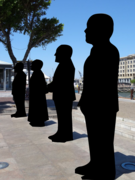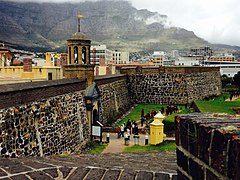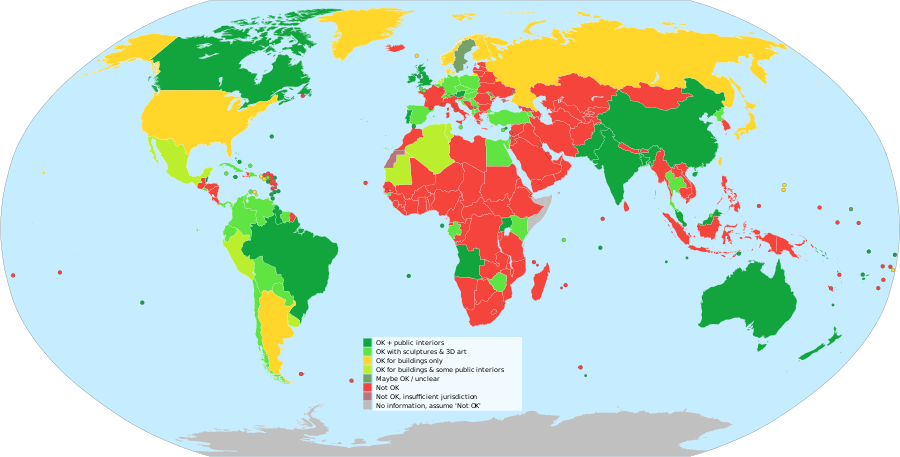Freedom of Panorama ZA
The importance of Freedom of Panorama for Wikipedia. For South Africa.
Facebook : #FoPforZA - Twitter : #FoPforZA
-
Nelson Mandela statue, Union Buildings, Pretoria.
-
Nelson Mandela statue, Union Buildings, Pretoria.
-
Gugulethu Seven Memorial
-
Mandela Capture Site
-
Nobel Square - V&A Waterfront
-
Rhodes Memorial
-
Voortrekker Monument
-
Castle of Good Hope
-
Boer War Womans Memorial monument
Current status[edit]
![]() Not OK
Not OK
The Copyright Act 1978 of South Africa (as at 18 June 2002), section 15(3), states: "The copyright in an artistic work shall not be infringed by its reproduction or inclusion in a cinematograph film or a television broadcast or transmission in a diffusion service, if such work is permanently situated in a street, square or a similar public place."
A diffusion service is defined in section 1(1) as "a telecommunication service of transmissions consisting of sounds, images, signs or signals, which takes place over wires or other paths provided by material substance and intended for reception by specific members of the public; and diffusion shall not be deemed to constitute a performance or a broadcast or as causing sounds, images, signs or signals to be seen or heard; and where sounds, images, signs or signals are displayed or emitted by any receiving apparatus to which they are conveyed by diffusion in such manner as to constitute a performance or a causing of sounds, images, signs or signals to be seen or heard in public, this shall be deemed to be effected by the operation of the receiving apparatus."
Since section 15(3) does not mention photographs, there is no freedom of panorama exemption in South Africa that would permit photographs of artistic works to be taken without infringing the copyright in the works.
A good example of what the impact of this section means in South Africa is how it legally affects the sharing of images on social media like Facebook or Instagram. Currently a person in South Africa can not legally take a photograph, video, or painting of a public artwork such as the front of a building and share it on Facebook. This is because the intellectual property of the front of that building, or that statue, or that public mural, belongs to the owner of that object which in tern means that you will need to get permission to distribute it on something like Facebook or Instagram or Wikipedia. The same is true of a painter painting landscapes or cityscapes so as to earn a living. The painter would need to get written permission every time they wished to sell one of their paintings that as a public artwork in it, they might even have to give the owner of that public artwork some money.
This situation remains the case with the current amended version of the bill up for review by Parliament.
Updating to allow for FoP[edit]
Ideally we would like the Copyright Act to be amended so as to allow for both Freedom of Panorama outside of buildings as well as inside and thereby bring the regulations into line with how they stand in Australia, India, and the United Kingdom (dark green on the world map above). Failing that we would like to have the act amended so that it will allow for Freedom of Panorama outside for buildings and 3D works of art (light green on the world map).
The sort of addition to the existing copyright act might be a section that would state something like the following: “general user right that is open to fair dealings and uses for any purpose, including for panorama.”
FAQ[edit]
- What is Freedom of Panorama?
- Freedom of Panorama is a copyright provision to allow the utilisation or reproduction of any type of multimedia of public artwork such as buildings, sculptures or any art installation which are permanently displayed in public spaces without infringing on the author's copyrights.
Other FAQ and Answers
- This does not change moral, privacy and personality rights that might go with the images.
- The current ambiguity in the law does not offer enough protection. A good illustration of this is the situation in Sweden which has a similarity vague law on the issue. A photographer was taken to court for sharing a photograph of a public fountain and lost.
- We charge people when they want to use our public spaces to promote their private products which they want to make a profit from. We call that advertising. In this case a sculpture's value to a large extent comes from it being installed in a public square. The author is paid upfront for the artwork, and gets additional income from using the public space as an advertising space.
- Although the content industry is not asking anyone to take down photographs of the Mandela Capture Site from online sites. In fact, the collecting societies are saying that users can use these photographs on social media and they won't go after them. Nevertheless, the use of this images is legally a clear copyright violation. This means that the collecting societies are admitting copyright rules and real-life don't match and are actively encouraging us to disregard it.
- Architects in countries with a full FoP exception don't earn less money than their colleagues in countries where this liberty isn't granted.
- The incentive to create and pay for architecture comes from the fact that the work will be part of the public space.
- FoP was first introduced in Bavaria in the 1830s to make sure street painters won't be put out of a livelihood by newly established copyright provisions. FoP is thus meant to protect authors and facilitate creativity.
3-Minute Pitch[edit]
How to best briefly describe the issue and promote our solution?
- Two stories:
- If you go on holidays to countries like Namibia, Nepal, Italy or Iran and share your holiday photos on Facebook or your blog, many of them will be infringements of copyright and other laws. The reason for this is that architecture, as a work of art, is protected and images thereof are considered derivative works. This means that to follow the law you'd have to ask each architect for permission for each building you want to take a picture of until 70 years after her/his death. In Italy you also have to ask a public official.
- In an attempt to comply with the law, the European Parliament gave Wikimedians a written permission to use an image of its building in Strasbourg. It turned out that even the Parliament doesn't own the rights to its own building and isn't allowed to give usage permission other than for "news purposes". That doesn't cover Wikipedia or even a MEPs own website. The same situation exists for South African law makers in relatively new buildings such as the Department of Trade and Industry's campus in Sunnyside, Pretoria.
- Many countries have an exception to copyright, that allows the free use of images located permanently in public spaces. We call this exception Freedom of Panorama.
- Since this exception is optional under the current 2001 Copyright in the Information Society Directive, plenty of countries don't recognise it, while others have introduced it only partially.
- The result is a fragmented and confusing legal framework within South Africa that not only prohibits images of public places to be used freely, but results in legal insecurity for commercial and non-commercial projects. (argument 1)
- A "non-commercial only" exception won't work: Wikimedia projects allow the commercial re-use of content, for example, and Facebook and Twitter are for-profit (i.e. commercial) sites. (argument 2)
- In countries with a full exception like the UK and Germany, architects don't earn less money. The structure remains protected (i.e. from being copied in other buildings) but images become freely usable. (argument 3)
- Why was copyright created? To give incentive to authors. In this case the incentive of the architect is to build the structure, not use images. (argument 4)
- The only conceivable practical solution to ensure freedom of expression, which in the internet age includes sharing pictures of public spaces, and a predictable legal environment is to harmonise the Freedom of Panorama exception on the EU level.
External links[edit]
- Freedom of Panorama, explanation of the concept on Wikimedia Commons.
- Freedom of Panorama Copy Right Act suggestions, submission by Wikimedia ZA to the DTI outlining our suggested recommendations to update the Copyright Act of 1978.
- Impact of no Freedom of Panorama in South Africa by Mapmyway.
- The current Copyright Bill archive copy at the Wayback Machine up for amendment by parliament.
- Recommendation by Creative Commons to update the Copyright Act of 1978
- Presentation to the South African Parliament on the importance of Freedom of Panorama in August 2017
- Copyright Amendment Bill update page on meta.wiki. This page keeps track of the effort to amend the bill to allow for Freedom of Panorama.









